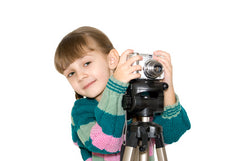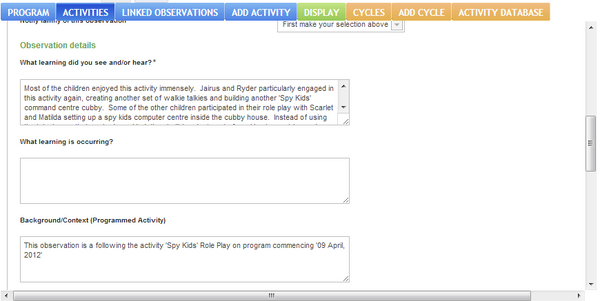Key links to Early Years Learning Framework (EYLF) EYLF Principle 4. Respect for Diversity EYLF Practice 5. Learning Environments EYLF Practice 6. Cultural Competence EYLF Outcome 1. : Children Have a Strong Sense of Identity EYLF Outcome 2. : Children are Connected With and Contribute to their World
One of the contemporary issues facing educators and families today is raising children to become culturally competent and sensitive from a young age. When interacting with people whose culture and background are different from their own, children need to learn how to respect and accept these differences, else they risk growing up into adults who contribute to problems brought about by discrimination. Only by teaching children cultural competence can we hope to have a society based on mutual respect and acceptance.
 Turning Differences into Opportunities
Turning Differences into Opportunities
As an early childhood educator, how would you respond to confronting statements such as these: “Maria can’t really speak English well, can she? Is she stupid?” or even: “Michael says Keisha’s skin is so dark because it’s very dirty”.
Children are naturally curious about the people around them. They attempt to formulate a sense of their own identity by defining what makes them different from everyone else. Thus, a child will typically ask questions about observable characteristics like skin color, accent, or manner of dress. “Children are around two or three when they begin to notice physical differences among people” (Kupetz, 2012). For the most part, these questions are innocent and not motivated by any intention to offend or hurt. It is therefore, up to the parents and educators to use these opportunities to send a fair and accurate message about each culture, so that children learn that these differences only makes a person unique, not inferior.
Take the case of Inigo, a kindergartener who recently migrated to Adelaide with his family. On his first day in his new school, his classmates noticed that he spoke English with an accent, and that his hair and skin was darker than most of his classmates. His teacher, instead of ignoring these observations or forbidding the students to verbalize them, explained that his hair and skin were darker because his parents had dark hair and skin too. She also explained that he spoke English with an accent because he spoke Spanish and was still getting used to English. She pointed out that there are different sounds of accents which mostly depend on where you come from, such as American accents, British accents, and even Australian accents. The educator may also find opportunities to extend an appreciation for Spain, including facts about Spain and Spanish people. A quick check on Google could also lead to some fun fact discussions like the fact that there are no tooth fairies in Spain - instead, there is a tooth mouse named Ratoncito Pérez!
Addressing such observations and questions about differences is a proactive way to foster cultural competence. The teacher can maximize the potential for learning by helping students see each cultural encounter as an enriching experience. “The process of intercultural interaction, of contact between people from different cultural backgrounds and a readiness to learn from one another, is the real foundation for equality” (Balcock 2010, p.33).
Role Model More Than Just Tolerance! Teach Enrichment from Difference
Understanding the impact of the environment children are raised in, including the child’s own culture, family, social and educational settings, is vital for both parents and educators who will need to work collaboratively to actively prevent development of bias in young children. Foremost to this is for the key adults in a child’s life to be sensitive to the fact that young children are always observing their behaviours, both good and bad. Children base their concept of right or wrong according to what adults around them are saying and doing; they take adult behavior as cues for social expectations and norms (Wilson, n.d). It is for this reason that educators need to find numerous opportunities to display desirable behaviours. In practice this means that educators need to find ways for children to become familiar with, understand and if possible even experience joy from difference. Families NSW (2011) recommends simple examples ways to embrace diversity within an early childhood setting:
· Make a point of acknowledging where all the children in the group come from by simply hanging a map and tagging locations with the child’s name and country of origin.
· Showcase a country each week or month and take the opportunity to invite parents to share words or phrases from their language, songs, music, food, traditional dance and costumes.
· Celebrate culturally diverse calendar events throughout the year.
· Display and make accessible multicultural and multilingual resources.
Cultural Competence - It’s Not Enough to Just Raise Cultural Awareness
Child Australia (n.d) argues that it is not enough to have cultural awareness, cultural knowledge and cultural sensitivity. Instead educators need to implement a multi-dimensional approach which includes not just strategies to enrich through difference but also strategies to actively manage bias when it occurs. Here are some strategies to counteract bias:
· When confronted, openly discuss and acknowledge difference
When a child points out that a certain person is different, he or she is merely making an observation, and not a malicious statement. It is therefore up to the educator to come up with a response that includes three important elements. First, the response should acknowledge that the observation is indeed valid. Second, the response should also explain the reason behind the observation and finally, the response should foster awareness towards a more respectful and accepting attitude. In the beginning of this article, one of the statements that we cited was:
“Maria can’t really speak English well, can she? Is she stupid?”
Incorporating the three key elements of acknowledge, explain and awareness, a good response to this statement would be:
“Yes, Maria can’t speak English as well as you but that is just because it is not the language which she uses at home. In fact, because she can speak Spanish really well and is also getting really good in English. Learning another language is difficult and she is actually very clever learning to speak two languages. You see, there are a lot of languages in the world, and each country has its own language. Maria just happened to be from a country where their language was Spanish. Did you know that Spanish and English both originated from Latin so there are some words that are very similar?”
· Using creative means that encourage children to reflect on their own behaviour.
If a student comes up to you and blurts out: “Michael says Keisha’s skin is so dark because it’s very dirty”, simply responding “No, that’s not true” is not going to make children truly understand the fallacy of such statement. Instead, you need to come up with an explanation which their young logic can process. For instance: “Your hair is dark brown instead of blonde like Sade’s. Does that mean that your hair is dirtier than hers?” This response will help them understand that the being dark is not an issue of hygiene, and help remove the stigma attached to being dark-colored.
· Responsibly intervening when bias-related incidents occur at home or in the classroom.
An adult who chooses to do nothing when a bias-related incident such as teasing or name-calling occurs is effectively endorsing such behavior. When you learn that such behavior has been committed, take the time to deal with it in a calm, non-punitive manner. In a matter-of-fact tone, simply formulate a response incorporating the key elements of acknowledge, explain and awareness. Make it clear that discriminatory behavior is extremely undesirable and will not be tolerated.
· Equip children with techniques that will enable them to respond appropriately when they experience or witness discriminatory behavior.
By exemplifying model behavior about cultural acceptance, you are helping children in your care understand how to deal with discriminatory behavior. While this is good, take note that children may be unable to verbalize or formulate appropriate responses without guidance. If needed, you can sit them down (individually or as a group) and teach them how to politely respond to biased and discriminatory statements.
· Get strategic
Understanding cultural influence in our environment requires educators to actively seek and investigate not just the influences of the child’s family, but also the influences within the service, the community and from themselves (NCCC, 2001). This could be done through a range of ways including:
- Team meetings and brainstorming;
- Surveys and questionnaires;
- Self assessment and review of systems, policies, procedures and practice;
- Other questioning and self assessments like: Are the basic needs for inclusion of all persons using the service being met? Does the service need to provide more help, fact sheets, information or other forms of support?
- Discussions with families and collections of family information and if possible cultural artifacts.
- Collating observations of children
Educators can ask themselves how highly services value diversity. Where are their differences? Are these differences physical? Do these differences confront any persons within the service’s values, principle or ideals? What can I actively do to preemptively eliminate or reduce bias?
Promoting inclusion and cultural competence can often be very challenging and take a long time to implement into practice. Hence it is recommend that educators create simple strategic plans that map out short and long term strategies for change and improvement. This way all stakeholders can ‘move together’ towards fostering a culturally competent learning environment.
Authors: Natalie Higgins and Chyrstal Ventura
About Raise Learning
This article has been written by Raise Learning, providers of LIFT (Learning Involving Families & Teachers - an online programming and documentation tool) and other early childhood management tools. If you would like to know more about Raise Learning or LIFT please visit our home page.
Further information and links for diversity, inclusion and cultural competence?
For more resources on promoting diversity and equity during the early years, you can the websites listed below or get in touch with various organisations dedicated to this cause. For instance, the Anti-Defamation League (ADL) (link to www.adl.org) regularly holds workshops for teachers and families so that they can be better equipped with skills and tools for coping with multi-cultural issues.
http://www.teachingenglish.org.uk
http://www.multiculturalaustralia.edu
http://nccc.georgetown.edu
http://www.earlychildhoodnews.com
http://www.racismnoway.com.au
http://amf.net.au/
References:
Peter Baldock. 2010. Google Books. [ONLINE] Available at: Accessed 06 March 12.
Banks, J. A , 2010. Multicultural Education: Issues and Perspectives. 5th ed. Washington: AK Press.
Child Australia Accessed 06 March 12
Families NSW (2011) Celebrating Cultural Diversity in Early Childhood Services retrieved 7/03/2012
Barbara Kupetz, Early childhood NEWS - Article Reading Center. 2012. Early childhood NEWS - Article Reading Center. [ONLINE] [Accessed 05 March 2012].
The Miller Early Childhood Initiative of A WORLD OF DIFFERENCE® Institute. 2012. The Miller Early Childhood Initiative of A WORLD OF DIFFERENCE® Institute. [ONLINE] [Accessed 05 March 2012].
National Center for Cultural Competence (2011) The Role of Self-Assessment in Achieving Cultural Competence. The Cultural Competence Exchange, Issue 4. Retrieved 7/3/2012
Sue Wilson (no date) Fostering Goodness & Caring: Promoting Moral Development of Young Children retrieved 7/3/2012
Diversity in Practice tip sheet, retrieved 7 March 2013














 Being an educational leader in an early childhood service is a hugely challenging role, particularly in light of changes to curriculum that have occurred over the last two years with implementation of the new National Quality Standard and the Early Years Learning Framework.
Being an educational leader in an early childhood service is a hugely challenging role, particularly in light of changes to curriculum that have occurred over the last two years with implementation of the new National Quality Standard and the Early Years Learning Framework. 


 Turning Differences into Opportunities
Turning Differences into Opportunities